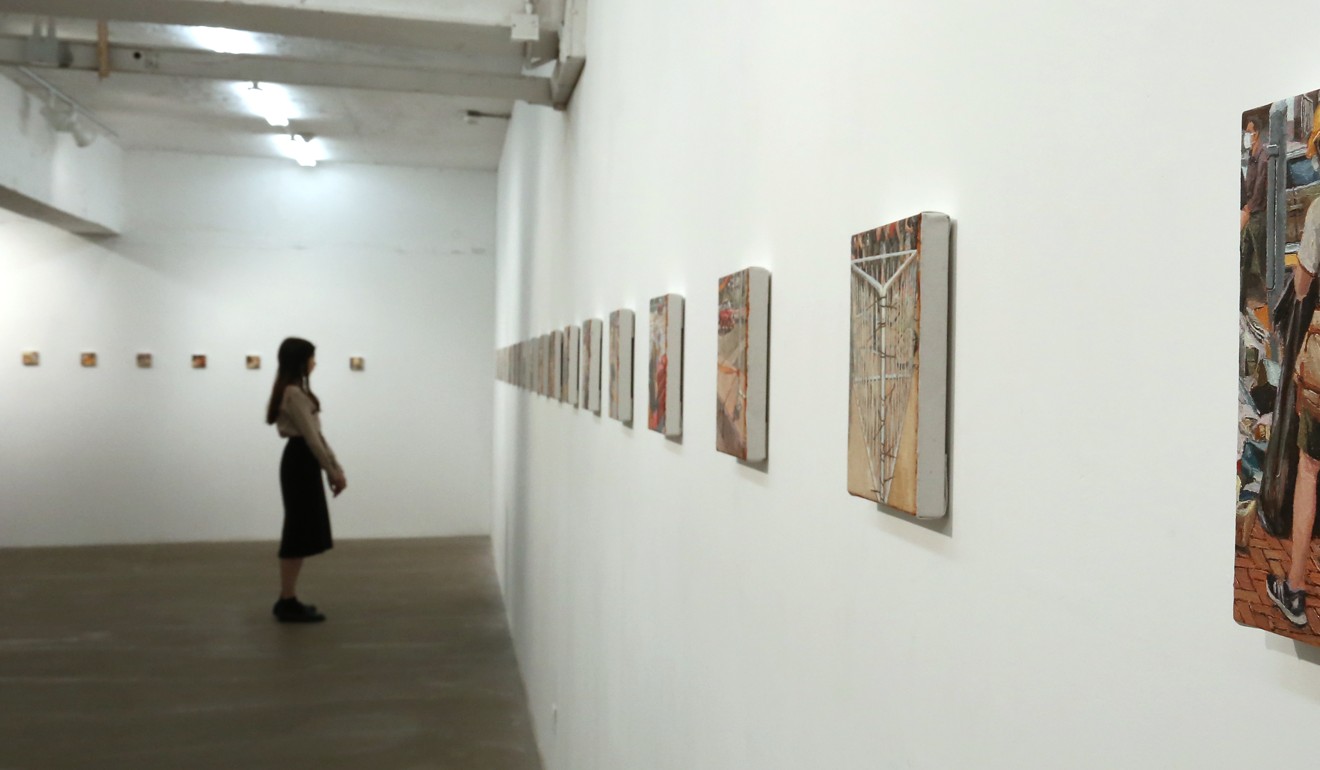
Hong Kong protest art: ‘dystopia’ of street violence captured in paintings taut with emotion
- Chow Chun-fai’s exhibition Portraits from Behind features his depictions of scenes from the recent anti-government protests in Hong Kong
- Most of his works are painted from photographs taken by the artist during the protests, often away from the front lines
For Hong Kong artist Chow Chun-fai, the most dramatic scenes aren’t always the most visible. At the height of last year’s anti-government protests, what he witnessed on the roads leading to the campuses of the Chinese University of Hong Kong and Hong Kong Polytechnic University in November had the most impact on him.
“The entrance [to the CUHK campus] was jammed with cars, the only way to get in was by bike. I was on my motorbike and what I saw was so dramatic,” recalls the 40-year-old painter.
He captures the more turbulent visuals on the smallest of canvases – where the style of painting becomes more impulsive. These works will go on show in his latest solo exhibition, “Portraits from Behind”, which opened at Gallery Exit in Aberdeen on March 14.

Painted mostly from photographs taken by Chow himself during the protests, the works are reactive, and taut with emotion. They were born of a desire to grapple with the turbulence of the past nine months, and the artist never intended for the works to be exhibited.

“I didn’t expect to show these works, I wanted to make a record for myself. Since June, I was unable to continue with any of my other projects, but I started painting these on June 12 [the first day that the police fired tear gas and rubber bullets],” he says.
Initially, he found it easier to take photos, but as the situation escalated, it became harder for him to document events. “I’ve been scolded by the front liners, [telling me] ‘don’t take photos!’” He describes an instance in New Town Plaza, Sha Tin, when a woman had her phone taken away because front line protesters thought she was taking portraits of them, prompting him to take pictures with his phone facing down, capturing people’s bottom halves and the floor, as depicted in New Town Plaza.
He was also ordered by the police to stop taking photos as he passed Government House. “I saw so many police at Government House; the gate was closed, in front of which the police told me to ‘keep walking, don’t stop, you are in a very dangerous situation,’ Chow reflects. “I think he meant the traffic, but the statement was ironic.”

This scene is reflected in Government House, an untypical protest image. Chow emphasises the distinction between his pictures and press photos. He characterises his as being literally taken from “behind” the protests, documenting aspects that aren’t always the centre of action.
Chow says the unrest has changed the way he paints. He says: “In the past I might think it’s too direct and shallow. A younger me wouldn’t do this, it’s too obvious. But this is a very important reaction for me. It’s speaking to myself. When you speak to yourself you don’t have to be filtered. You just say the sentence directly, that’s why it’s much more emotional than what I’ve created in the past.”

Chow is perhaps best known for a series of paintings he did in 2007 entitled “Painting on Movies”, depicting scenes from popular films layered with text. The biggest difference between his earlier and most recent series is that the former relies on fiction and historical research, while the latter documents reality.
“These are a result of research,” he says of the “Painting on Movies” series. “There was a history to them before I painted the different interpretations which included texts and not just scenes from the films.”
In one work, a scene from 2002 crime thriller Infernal Affairs is painted with the subtitles, “I want my identity back.” In another, a scene pictured from Ann Hui’s 1984 film Love in a Fallen City contains text which reads, “I can’t claim to be a real Chinese.”

“For [Portraits from Behind] however, it’s directly captured from my real life – or Hong Kong’s real life,” Chow says. “I suspect this work will have, and create, its own history. In the future, the meaning of the work will also change based on what happens.”
I’m not a reporter trying to capture typical news images. I’m just capturing the back of the protesters as opposed to what is happening on the front line
Portraits from Behind
EXIT, 3/F, 25 Hing Wo Street, Tin Wan, Aberdeen Open: Tue to Sat, 11am to 6pm galleryexit.com
The exhibition runs from March 14 to May 16

